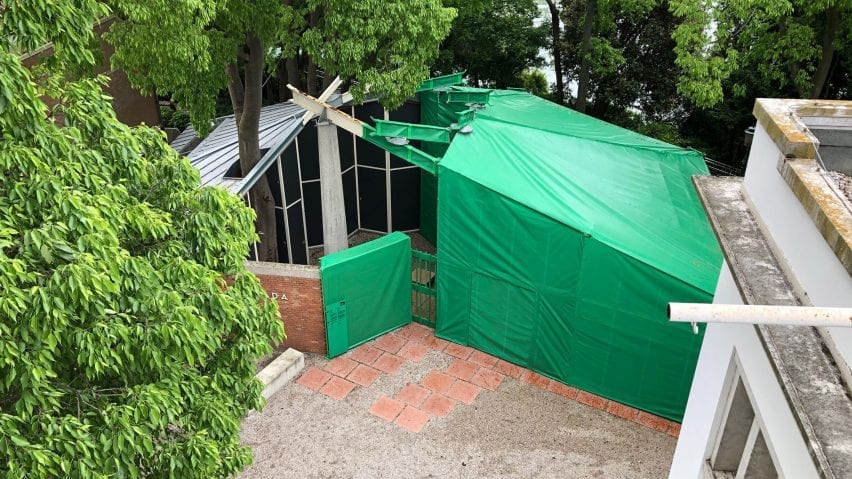Montréal studio TBA has wrapped the Canadian pavilion at the Venice Architecture Biennale in a green screen so that it can be replaced digitally with other buildings.
Called Impostor Cities, the pavilion was designed to be a comment on architectural authenticity focusing on the way Canadian cities are often used to portray other places in films.
"The Pavilion celebrates the protean Canadian cities and buildings that pose as cinematic doubles," said the pavilion's design team.
"Challenging visitors to think about architectural authenticity, the onsite and the onscreen, at a moment when the blurring of fact and fiction takes on an important significance."
TBA and curator David Theodore aimed to drastically alter the appearance of the Canadian pavilion, which was designed by Italian studio BBPR in 1958 and was recently renovated.
It has been largely wrapped in green sheeting to give the building a dramatic impact.
"Dramatic is the right word, but also theatrical, mischievous, and cinematic," the design team told Dezeen.
"Wrapping the structure in a green mesh fabric highlights its quirky spiralling profile," they continued.
"The wrap changes the pavilion into an icon visible across the Giardini, in bold contrast to our neighbours, the staid British, German, and French pavilions. Even at a distance visitors will instantly identify our theme of architecture and cinema."
The green mesh disguises the building and gives the impression that the pavilion's renovations are still underway.
"It's about architectural identity and faking it," they continued.
"We hope visitors think that the pavilion is under renovation again and that then they discover they can digitally erase and replace the pavilion with Canadian impostor buildings."
The wrap also allows the building to be used as a digital green screen.
Using an Instagram filter called Svela-Finzione, which translates into English as "reveal the fake", visitors can replace the pavilion with a building in Canada.
"If you're standing there, you see a green-wrapped building," said the tam.
"If you look through your camera, you see buildings from Canada digitally inserted in the place of the Pavilion. The wrap flips the script, making movies double as architecture."
Within the pavilion is an exhibition that aims to highlight when Canadian buildings and cities have been used to represent other places in the world.
"The exhibition shows visitors that the fictional worlds they see onscreen are likely to be Canadian cities," said the team.
And it challenges them to reimagine what it means to experience architecture. The cities we inhabit together onscreen are meaningful and valuable ways to live together in a changing world."
Germany's 2038 pavilion at Venice Architecture Biennale also utilised digital technology with QR codes placed on the walls of the empty building. Scanning the codes allowed visitors to watch movies explore the world in 2038.
We rounded up 10 of the best pavilions from the 2021 Venice Architecture Biennale that respond to this year's theme of How will we live together?
The photography is courtesy of Impostor Cities.

